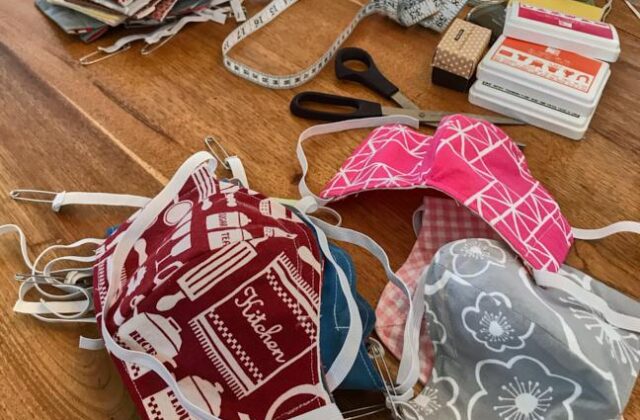Local Stitchers Are Busy Making Face Masks to Combat the Coronavirus
Sewing for Safety
By Ruth Melville
Photo by Avice Meehan
Back in March—which feels like a long ago now—it was rare to see a person on the street wearing a face mask. It seemed too extreme, and slightly scary. But as doctors and scientists began to learn more about Covid-19, it became apparent that even people without symptoms could transmit the disease. Eventually the World Heath Organization and the Centers for Disease Control (CDC) recommended that people wear masks in public settings. In Connecticut, it is now mandatory to wear a face mask wherever close contact is unavoidable, such as in a grocery store.
But where were all these masks going to come from? There is only a limited supply of surgical masks and N95 respirators, and they were desperately needed by health-care personnel. Luckily, even a fairly simple cloth mask can provide some protection, and there was an army of home sewers waiting to do their part to prevent the spread of Covid-19.
Norfolk resident Avice Meehan is a longtime, skilled seamstress. On Twitter, she read about a woman, a pediatrician, who was sewing her own face masks. Meehan has a background in health care and was “looking for something concrete and meaningful” to do. She started riffling through her piles of fabric to see what she had the she could use to start making face masks.
She checked out different sewn versions online, and came up with one that incorporated the features she liked best. Her mask, which she prototyped before going into production, is shaped and has two cotton layers, the inner one flannel; a nose wire for tighter shaping over the bridge of the nose; and a string of elastic for an adjustable fit. (A baggy mask is not effective.) The masks can be washed in hot, soapy water and re-worn.
The first masks she made went to people she knew who had health issues and would need them the most. Then she says, “It just built out from there.” She started with her own Norfolk neighborhood and expanded to family and friends. She gives all of her recipients two masks, so one is ready while the other is being washed and dried. She has no trouble buying more fabric, but elastic is so hard to find that she has to source hers from Manchester, England. Other neighbors are now helping her with cutting out the pattern, and so far she and her mini-team have made over 200 masks.
Meehan has also joined with another group in this area, the CT Fifth District Face Mask Task Force 2020, which was organized by Lakeville Interiors and the Kent Quilters. The group has over 190 volunteers working with them, several from Norfolk, and has already made over 2,500 masks. The majority of the masks they’ve made have gone to local hospitals, visiting nurses associations, assisted-living and nursing homes and soup kitchens. At Meehan’s request, the task force also donated 150 masks to Journey Home, a homelessness service provider in Hartford.
If you are interested in volunteering with, or donating to, the Face Mask Task Force, you can contact them at NWCTmaskmakers@gmail.com.
There are similar groups forming across the Connecticut and all the other states. For people who like to create beautiful objects, there is a strong impulse to craft for a cause. During World War II, Knitting for Victory campaigns in both the United States and the United Kingdom saw women knitting socks, gloves and balaclava helmets for the soldiers. More recently, knitters worldwide made little sweaters for oil-slicked penguins in Australia—so many that the authorities there didn’t know what to do with them all.
Even the not-so-crafty have been inspired to help out during the current pandemic. The novelist Margaret Atwood said in a recent article in the Guardian newspaper that she has dragged out her old sewing machine and oiled it up so she could sew face masks. And with clothing stores closed worldwide, even high-end fashion brands like Prada, Yves Saint Laurent, Gucci and Balenciaga have started making masks.
During this time of lockdown and social isolation, these projects are also a good way for people to come together and feel part of a common purpose. As an added benefit, many crafters find the repetitive, immersive actions of knitting or sewing to be very relaxing.
In addition to the resources mentioned above, the CDC also has on its website (www.cdc.gov) directions for both a sew and a no-sew version of a cloth mask, along with advice on how to wear one correctly.

